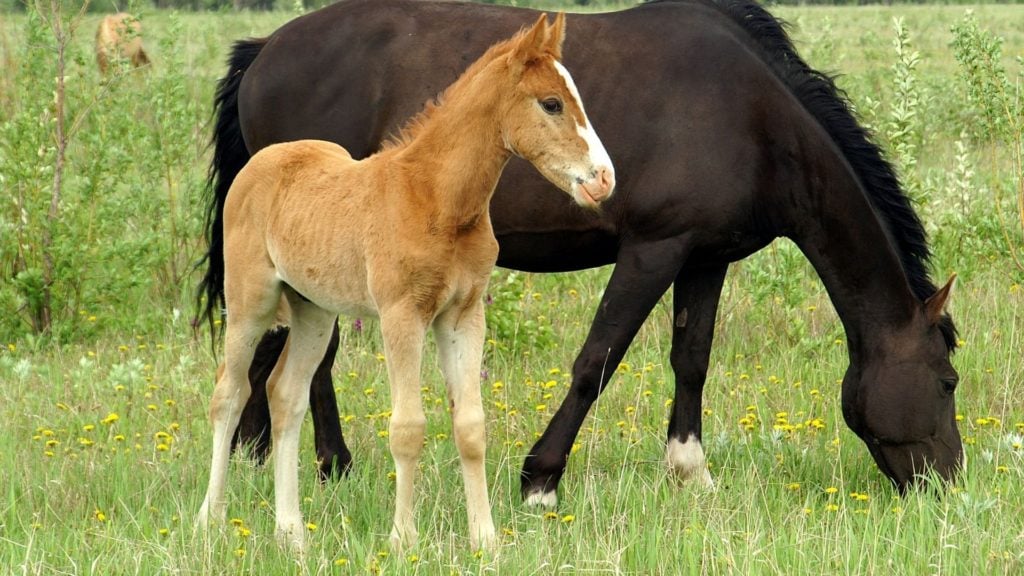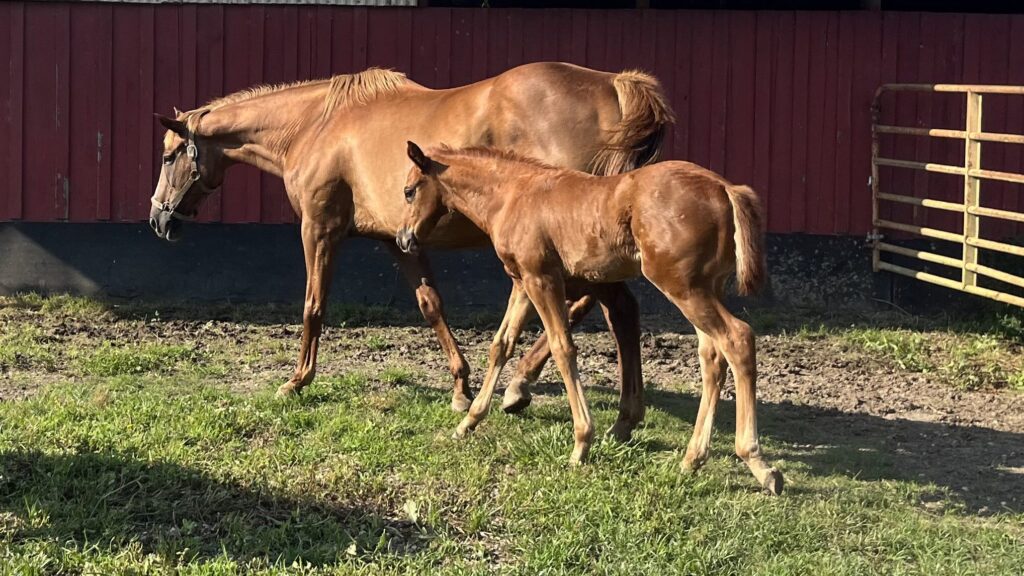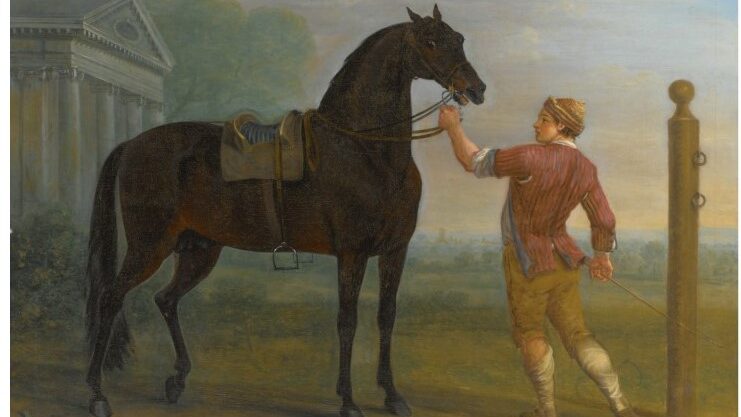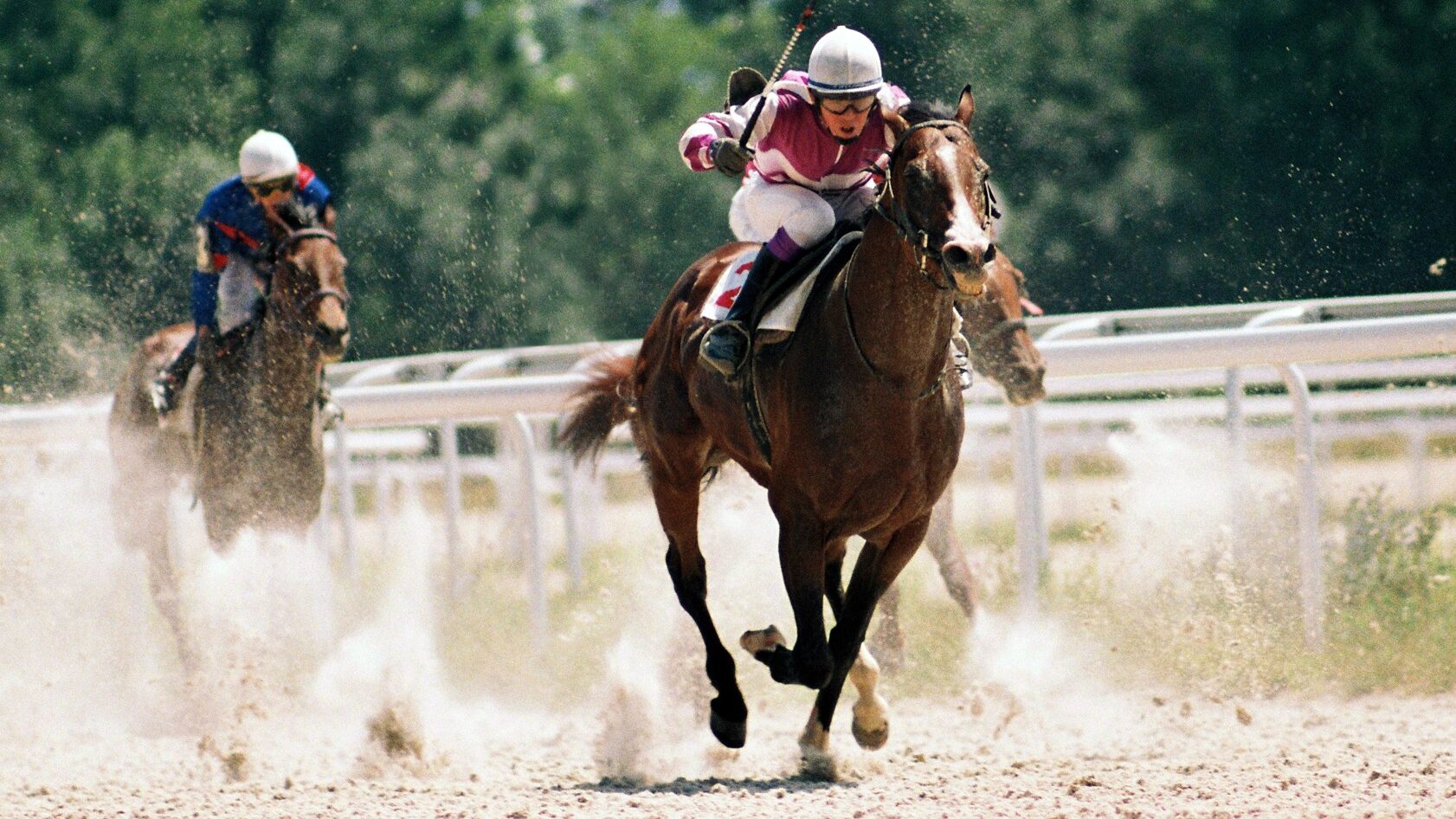Last updated: August 12, 2024
Have you ever wondered how racehorses are bred? There is a lot that goes into the process, and it can get quite complicated. For a foal to be registered as a Thoroughbred racehorse, the sire and dam must engage in ‘live cover’ mating, as artificial insemination is not allowed in this breed. In contrast, Quarter Horse broodmares can be bred either through live cover or artificial insemination, providing more flexibility in the breeding process.
Racehorse breeding merges time-honored traditions with modern science, combining age-old practices and cutting-edge research. This blog post delves into the captivating interplay between tradition and science, revealing how they collaborate to produce future champions.

The Tradition of Racehorse Breeding
The art of breeding racehorses has a rich history, deeply rooted in tradition. For centuries, the primary method of breeding Thoroughbreds, one of the most prestigious racing breeds, has been through ‘live cover.’ This method involves the physical mating of a stallion (male horse) and a mare (female horse) without any artificial intervention.
In the past, breeding choices were often based on the physical attributes and racing performance of the horses. Breeders would select the strongest, fastest, and most resilient horses to mate, hoping to pass these desirable traits onto the next generation. This practice was as much an art as it was a science, relying heavily on the breeder’s knowledge and experience.
Significance of ‘Live Cover’ in Thoroughbred Breeding
‘Live cover’ remains the only accepted method of breeding for registering a horse as a Thoroughbred. This rule is strictly enforced by major horse racing and breeding organizations worldwide. The rationale behind this is to preserve the purity of the breed and maintain a level playing field in the sport. It ensures that all Thoroughbred horses are bred under similar conditions, keeping the focus on natural abilities rather than technological advantages.
Cultural and Regulatory Aspects
The tradition of ‘live cover’ breeding is not just a matter of regulation; it’s deeply ingrained in the culture of horse racing. It’s seen as a way to honor the sport’s history and integrity. This method has been passed down through generations, with each breeder adding their knowledge and expertise to the process.
Breed-specific regulations have their origins in these long-standing traditions. For Thoroughbreds, organizations like The Jockey Club in the United States and similar bodies in other countries set the breeding rules. These regulations are designed to protect the breed’s lineage, ensuring that each new generation of racehorses meets the high standards set by the racing community.

Modern Science in Racehorse Breeding
While modern science offers significant advantages in racehorse breeding, it also presents a set of ethical and practical challenges that need careful consideration. The balance between embracing technological advancements and respecting traditional breeding methods is a delicate one, requiring ongoing dialogue and thoughtful regulation in the equine community.
Technological Advancements in Breeding
- Artificial Insemination and Its Impact:
- Introduction: Artificial insemination (AI) is a modern breeding technique where sperm is collected from a stallion and artificially introduced into a mare’s reproductive tract. This method is widely used in many horse breeds, though not in Thoroughbreds.
- Impact on Breeding: AI allows for greater flexibility in breeding choices. It enables breeders to use stallions from distant locations without the need for physical transportation, broadening the genetic pool. This method can also reduce the risk of injury and disease transmission that might occur during live cover.
- Genetic Testing and Selection:
- Role in Breeding: Genetic testing has become a crucial tool in modern horse breeding. It allows breeders to identify specific traits and genetic markers that could indicate potential for speed, endurance, and overall health.
- Application: By understanding a horse’s genetic makeup, breeders can make more informed decisions, selecting mating pairs that are more likely to produce offspring with desired characteristics.
Here is an educational YouTube video about breeding racehorses you may find interesting.
Benefits and Challenges of Modern Methods
- Advantages of Modern Breeding Techniques:
- Broader Genetic Diversity: AI and genetic testing contribute to a wider genetic diversity, which is vital for the health and vitality of horse breeds.
- Enhanced Safety and Health: These methods can reduce the physical risks associated with live cover and help in the early detection of hereditary diseases.
- Precision in Breeding: Genetic testing offers a level of precision in predicting and cultivating desired traits in racehorses, potentially leading to a higher success rate in breeding champion horses.
- Ethical and Practical Challenges:
- Ethical Concerns: The use of AI and genetic manipulation raises ethical questions about the extent of human intervention in natural processes. There are concerns about creating a ‘designer horse’ and the implications for the animal’s well-being.
- Regulatory Hurdles: In breeds like Thoroughbreds, where AI is prohibited, there’s a debate about whether to embrace these modern methods. Traditionalists argue for preserving the natural breeding methods, while others advocate for the benefits of technological advancements.
- Practical Challenges: Implementing AI and genetic testing requires significant investment in technology and expertise. Ensuring that these methods are used responsibly and ethically is also a challenge.

Artificial Insemination in Racing Quarter Horse Breeding
Unlike Thoroughbreds, racing Quarter Horses have more flexibility in their breeding methods. The American Quarter Horse Association (AQHA) allows for artificial insemination, a modern breeding technique that broadens genetic diversity and offers practical advantages. Learn more about AQHA guidelines.
Semen Collection Process
- Initial Preparation:
- The process begins with a thorough cleaning of the stallion to maintain sanitary conditions, which is crucial for successful artificial insemination.
- Stimulating the Stallion:
- A mare in heat is introduced to stimulate the stallion. This natural method ensures the stallion is ready for semen collection.
- Using a Dummy Mount:
- The stallion is then encouraged to mount a dummy fitted with an artificial vagina and a sterile collection bag. This setup safely and effectively collects the semen.
Insemination Procedure
- Preparing the Mare:
- The mare’s tail is wrapped and held aside for cleanliness. The veterinarian then cleans the mare’s vagina and surrounding area to prevent infections.
- Insertion and Insemination:
- A specialized tube is carefully inserted into the mare, extending into the uterus. The collected semen is then injected through this tube, ensuring precise delivery to the uterus.
- Monitoring Ovulation:
- Post-insemination, the mare is observed for ovulation. If necessary, medication is administered to induce ovulation, increasing the chances of successful conception.
Pregnancy Confirmation
- Using Mobile Ultrasound: A mobile ultrasound scanner can be employed to confirm pregnancy. This technology allows for early detection of pregnancy, ensuring timely care for the mare. Check out our product review page for information on mobile ultrasound devices.
This detailed look into the artificial insemination process in racing Quarter Horses showcases the blend of traditional animal husbandry with modern veterinary techniques. It’s a clear example of how science is advancing the field of equine breeding, ensuring the health and well-being of both the mare and the stallion while optimizing breeding outcomes.

Understanding the Risks and Complexities of Racehorse Breeding
Racehorse breeding is a venture filled with both excitement and uncertainty. It involves navigating a myriad of challenges to produce horses that not only excel on the track but also carry the potential to become the next generation’s champions.
Genetic Unpredictability and Bloodline Considerations
- The Genetic Lottery: Despite meticulous selection based on pedigree and bloodlines, breeding a successful racehorse remains a gamble. There’s no guarantee that even the offspring of champion racehorses will inherit the desired traits.
- Illustrating Genetics in Action: Take, for instance, Northern Dancer, the 1964 Kentucky Derby winner. His success on the track was only surpassed by his influence as a sire, shaping the bloodlines of countless winners. Yet, not every descendant of a Derby winner is guaranteed the same level of success.
Health and Well-being in Breeding
- Navigating Health Risks: The breeding process, from conception to foal birth, is fraught with potential health complications. Ensuring the health of both mare and foal requires constant vigilance and expert care.
Market Dynamics and Financial Implications
- Economic Fluctuations: The racehorse market is as unpredictable as the sport itself. Breeders must stay attuned to market trends and demands, which can significantly impact the value of their horses.
- Cost Considerations: The financial commitment to breeding racehorses is substantial. From stud fees to veterinary care, the costs can be daunting, especially when the return on investment is uncertain.
Competition and the Quest for Excellence
- A Crowded Field: The industry’s competitive nature means breeders are constantly vying to produce the next big winner, a challenge that requires both skill and luck.
- The Dream of Breeding a Champion: The ultimate goal for many is to breed a horse that not only wins prestigious races like the Kentucky Derby but also commands high stud fees. American Pharoah, the 2015 Triple Crown winner, is a prime example, with stud fees starting at $200,000.
Breeding racehorses is a complex endeavor that blends science, art, and a deep understanding of equine genetics. It requires balancing the risks with the potential rewards, always with an eye toward the health and welfare of the horses involved. For those passionate about the sport, the challenges of breeding are part of what makes the world of horse racing endlessly fascinating.

Strategic Considerations in Racehorse Breeding
Choosing the ideal horses for a breeding program in the racehorse industry is a multifaceted and critical process—success in breeding hinges on a combination of informed decisions and strategic considerations.
Key Factors in Horse Selection
- Pedigree Analysis:
- Importance: The lineage of the horses is paramount in predicting the potential of their offspring. A thorough examination of the sire and dam’s ancestry and racing achievements offers insights into the likelihood of breeding successful racehorses.
- Application: Breeders analyze pedigrees to identify desirable traits and potential for excellence in racing.
- Conformation and Physical Traits:
- Role in Selection: Physical attributes and structure are crucial. Horses with superior conformation are more likely to produce offspring capable of excelling in racing or other equestrian disciplines.
- Criteria: Breeders assess aspects like bone structure, muscle development, and overall physique.
- Performance and Progeny Records:
- Evaluating Success: The past performance of potential breeding horses, along with the success of their progeny, is a strong indicator of breeding potential.
- Data Utilization: Records of races, wins, and the performance of offspring guide breeders in making informed choices.
- Temperament Considerations:
- Inheritance of Disposition: Offspring often inherit the temperament of their parents. Breeders prefer horses with a calm, trainable nature to ensure manageable and trainable progeny.
- Market Demand and Trends:
- Market-Driven Decisions: Understanding current market trends for specific breeds or bloodlines helps in aligning breeding programs with market preferences, enhancing the commercial viability of the offspring.
- Genetic Health and Screening:
- Health Assessments: It is vital to ensure breeding horses are free from genetic disorders. Genetic testing and veterinary examinations are employed to prevent the spread of hereditary conditions.
Considering these factors, breeders can significantly enhance their chances of success. Breeding racehorses is not just about matching two horses; it’s about creating a legacy of champions through careful, strategic planning and a deep understanding of equine genetics and market dynamics.

Exploring Diverse Racehorse Breeding Theories
Over the years, humans have developed various theories on how to produce the ultimate racehorse. These methods range from traditional practices to more scientifically driven approaches.
Telegonic Theory: An Ancient Belief
- Historical Background: Telegonic theory dates back to Aristotle’s time. It posits that a mare’s previous mating partners can influence the traits of her future offspring.
- Modern Understanding: Current genetic research, however, disproves this theory. We now understand that offspring traits are determined solely by the genes of their immediate biological parents, with no impact from previous mates.
Linebreeding: A Popular Method
- Definition and Application: Linebreeding involves having an ancestor appear multiple times in a horse’s pedigree, typically through different offspring. This method aims to reinforce desirable traits.
- Genetic Implications: The practice is based on the understanding that a stallion passes his Y-chromosome to sons and X-chromosomes to daughters. Linebreeding, especially through both a son and a daughter of a notable horse, is believed to enhance desired qualities.
Pattern Breeding: Linebreeding with a Variation
- Concept: Pattern breeding is a nuanced form of line breeding. It involves replicating a specific pattern of ancestors in the broodmare with a similar lineage in the stallion’s pedigree.
- Goal: The aim is to increase the likelihood of passing on desirable characteristics by focusing on two or three influential ancestors in the same lineage.
Inbreeding: A Cautionary Approach
- Definition: Inbreeding refers to the duplication of ancestors within the first four generations of a horse’s pedigree.
- Risks and Current Stance: While there have been successes, inbreeding is now less favored due to potential health risks akin to hemophilia seen in European royal bloodlines.
Outcrossing/Outbreeding: Enhancing Genetic Diversity
- Purpose: Outcrossing, or breeding unrelated horses, is practiced to increase genetic diversity and reduce the risk of genetic abnormalities.
- Benefits: This method is particularly beneficial for mares with limited genetic variance. It introduces new DNA to the bloodline and potentially improves overall health and vitality.
While each method has its merits and drawbacks, the key lies in finding a balanced approach that prioritizes the health, genetic diversity, and potential of the racehorses. As breeding practices continue to evolve, informed decision-making remains at the heart of producing successful and healthy racehorses.
The Role of ‘Nicking’ in Racehorse Breeding
“Nicking” is a strategic breeding practice in the horse racing industry, focusing on pairing specific bloodlines to produce successful racehorses. It involves identifying combinations of stallion and mare lines that historically yield high-quality offspring.
A notable example is the pairing of Northern Dancer stallions with Star Kingdom broodmares, which has consistently resulted in exceptional racehorses. This approach highlights the importance of understanding and matching genetic traits to enhance racing potential.
With advancements in technology and genetics, the traditional role of professional nickers has evolved. Breeders now integrate historical data with modern genetic insights to make informed breeding decisions. This blend of tradition and science represents the contemporary approach to successful racehorse breeding, balancing historical knowledge with the latest advancements in genetic research.
The practice of nicking is instrumental in shaping the lineage of thoroughbred racehorses, skillfully blending traditional breeding wisdom with contemporary scientific insights. This approach is pivotal in cultivating the next generation of equine champions. Services like TruNicks offer valuable assistance in pairing broodmares and stallions, enhancing the potential for breeding success through informed and strategic matches.

The Future of Racehorse Breeding
The future of racehorse breeding is poised at an exciting intersection of tradition and innovation. As the industry moves forward, it will be essential to maintain a careful balance that honors the rich history of the sport while leveraging scientific advancements to improve the breeding and welfare of these magnificent animals.
Predictions and Trends
- Expert Opinions on Future Directions:
- Integrating Technology: Many experts predict a greater integration of technology in racehorse breeding. This includes advanced genetic testing to identify potential champions and the use of AI to broaden the genetic pool.
- Sustainable Practices: There’s a growing emphasis on sustainable breeding practices, focusing on the long-term health and welfare of the racehorses rather than just their performance capabilities.
- Potential Developments in Breeding Methods:
- Traditional Methods: While traditional methods like ‘live cover’ are expected to continue, especially in Thoroughbred breeding, there may be gradual adaptations to improve health and safety.
- Scientific Advancements: Innovations in genetic research could lead to more precise breeding strategies, potentially reducing the incidence of hereditary diseases and enhancing desirable traits.
Balancing Act
- Finding a Balance Between Tradition and Science:
- Respecting Heritage: The future of racehorse breeding lies in respecting the heritage and traditions of the sport while embracing beneficial scientific advancements.
- Adapting Regulations: This balance may require adjustments in breeding regulations, allowing for a more flexible approach that accommodates both traditional and modern methods.
Importance of Maintaining Genetic Diversity and Health
- Genetic Diversity: Preserving genetic diversity is crucial for the health and resilience of racehorse breeds. Overemphasis on specific traits or overusing certain bloodlines can lead to a genetic bottleneck.
- Overall Health and Welfare: The ultimate goal of breeding should be the overall health and welfare of the horses. This includes breeding for soundness, longevity, and a temperament suited to the demands of racing.
Conclusion: Breeding Racehorses.
As we’ve explored, the world of racehorse breeding is a fascinating blend of time-honored traditions and cutting-edge scientific advancements. From the steadfast practices of ‘live cover’ in Thoroughbreds to the innovative use of artificial insemination and genetic testing in other breeds, each approach plays a vital role in producing the champion racehorses of tomorrow.
Key Insights Recap
- Traditional Methods: These methods, deeply rooted in history, continue to be crucial in maintaining the integrity and heritage of breeds like Thoroughbreds.
- Modern Techniques: Scientific advancements offer precision and broaden genetic diversity, contributing significantly to the health and performance of racehorses.
The future of racehorse breeding lies in finding a harmonious balance between these two worlds. It’s about respecting the past while embracing the future, ensuring that ethical considerations and the well-being of the horses remain at the forefront of all breeding decisions.
Share Your Thoughts and Experiences
We’d love to hear from you! Share your thoughts and experiences in the world of racehorse breeding in the comments.
FAQs
Can genetic testing predict a racehorse’s success?
While genetic testing can provide insights into certain traits, it’s not a definitive predictor of success. Racing success depends on a combination of genetics, training, and care.
Is artificial insemination allowed in all horse breeds?
No, breeds like Thoroughbreds still require ‘live cover’ for registration, while others allow artificial insemination.
Additional Resources
For those eager to delve deeper into the intricacies of racehorse breeding, here are some valuable resources:
- The Horse: Your Guide to Equine Health Care – A comprehensive resource on equine health, including breeding.
- Journal of Equine Veterinary Science – Access scientific studies and research on equine breeding.
- Expert Interviews on Racehorse Breeding – Insights from industry experts on the latest trends in breeding.

About the Author: Miles Henry
Lifelong Horseman | Racehorse Owner | Published Author
Miles Henry brings over 25 years of hands-on experience training and owning Thoroughbred racehorses. Raised with Quarter Horses and Appaloosas, he’s spent a lifetime learning from horses—on the track, in the barn, and in the field. Today, he runs a small but successful racing stable in Louisiana and shares real-world insights on HorseRacingSense.com, helping horse owners, fans, and bettors navigate the sport with confidence.
📚 Books: View Miles’s books on Amazon »
🎧 Podcast Guest: Animal Tales Ep. 32 |
YouTube Interview
📩 Newsletter: Sign up for racing tips and horse care advice »
🔗 Follow Miles:
Twitter |
Facebook |
YouTube


